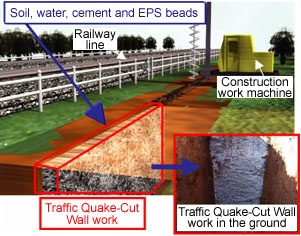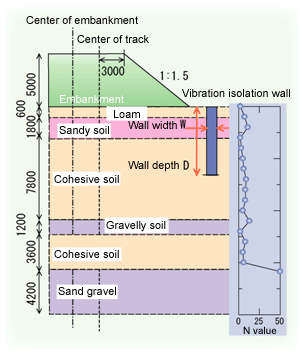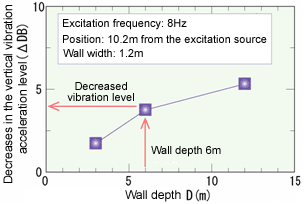| 7. Traffic quake-cutting (TQC) work (i.e. work to reduce traffic vibration) using walls made of soil cement mixed with EPS beads | |||
| |||
|
Continuous RC walls in the ground and steel sheet piles have been used to combat the ground vibration caused by running trains. Since vibration is expected in these rigid walls in tandem with the ground vibration, however, they need to be embedded deep in the ground down to the bearing stratum, increasing the installation cost per unit wall length. Since principal and strong ground vibration occurs near the ground surface, the RTRI developed a method using a traffic quake-cutting wall of between 3m and 6m deep, made of soil cement mixed with expanded polystyrene (EPS) beads (softer than the surrounding ground) to save on construction costs (Fig. 1). The RTRI performed a numerical analysis of an embankment on the soft ground (Fig. 2) and obtained the relationship between the depth of the wall and its vibration-reducing effect (Fig. 3). Traffic Quake-Cutting method using a sound isolation wall 1.2m thick and 6m deep shown in Fig. 3 is expected to decrease ground vibration by 4dB. The RTRI constructed a wall of this size to a length of 30m, decreasing ground vibration by between 2 and 3dB.  Fig. 1 An outline of the traffic quake-cutting work using a wall made of soil cement mixed with EPS beads
HOME > Major Results of Research and Development in Fiscal 2004 > IV Harmonization with the environment RTRI HOME Copyright(c) 2005 Railway Technical Research Institute,Tokyo Japan, All rights reserved. |

